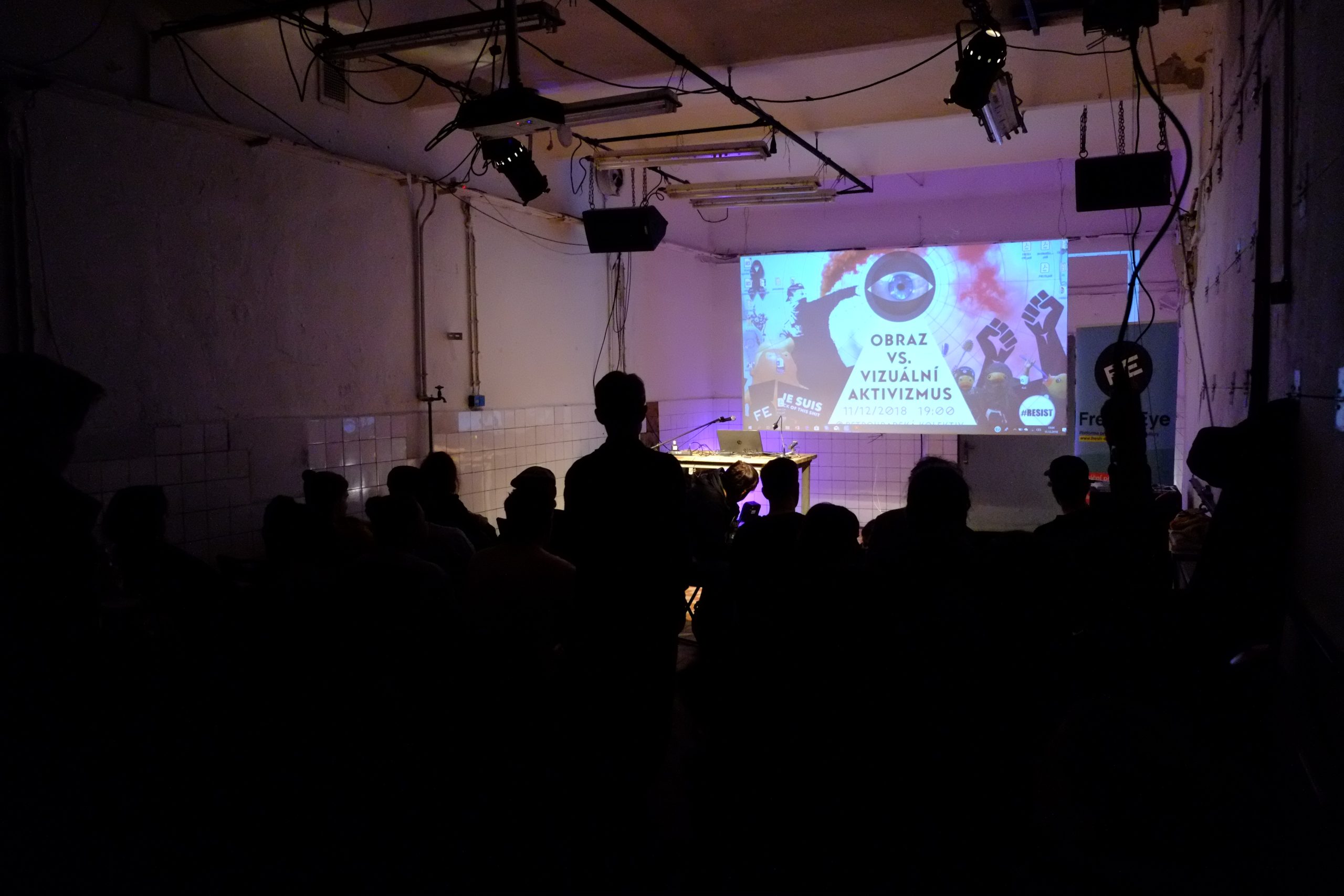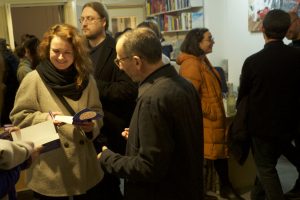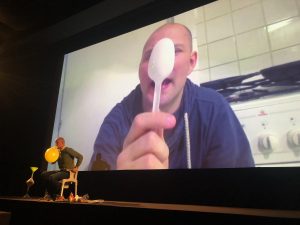This contribution oscillates between a theoretical essay and self-reflective account on how public education takes place today. In the first place, however, it is a revision. A revision of how successful a project of public visual pedagogy, imagined by a group of graduate students in Prague almost a decade ago in 2011, has been. This is a critical insight into our practice, as well as a ruthless critique long overdue. This critique derives from the idea of praxis as defined by Paulo Freire.[1] For Freire, praxis is a theoretical reflection (the revision of the project) conducted through a practice (of writing this text) in order to evaluate, reflect upon and eventually implement the reflection’s outcomes back into practice. This is a practical test and an open experiment, so any failure is welcome and seen as productive.
Nostalgia, or Precariat?
It was autumn 2011 when a group of graduate students of philosophy at Charles University in Prague agreed that there was something important missing in their curriculum. Even though they were frequently told that images and visual communication dominate contemporary culture, no tools were offered to understand this statement, or to analyse it. So, a hunt for learning more started, but quickly stopped as only a few original essays, local lectures and teachers were found able to share the interdisciplinary knowledge of visual culture. Without any institutional backing, financial support or development plan, they organised the first public lecture series under the title Fresh Eye, Platform for the Study and Promotion of Visual Culture. A friend-artist provided their studio as a venue, another friend developed the website, speakers participated for free and no admission fee was (and still is) required to attend the events.

The first Fresh Eye conference, University Teachers’ Discussion. Image courtesy Fresh Eye.
It is summer 2020 and there is a group of friends running the only platform supporting research, translation and local and international networking in the field of visual culture in the Czech Republic: Fresh Eye. We maintain a large video archive of more than 200 lectures and curate an online library touching upon topical issues. We organise monthly public lectures and quarterly film screenings introduced by a performance of local artists. We often travel around the country to meet students at primary and secondary schools in interactive workshops aiming to enhance their visual literacy. Every month, we publish a newsletter with local lectures, events, international calls for papers and recently published books. Some of us have kids, some of us have doctoral degrees, some of us have both and we all have bills to pay. The project, however, does not represent our main source of income as our budget goes mostly towards guest lecturers’ fees and production costs. We are adults now, so why do we invest so much time into such under-paid (if at all paid!) work? Two answers seem to be appropriate at this time: (1) The project brings us back to the nostalgia of idealism of our college times, and (2) We grew accustomed to living in the precarious conditions of freelance work, marked by the informal jobs in the cultural and HE sectors (zero-hours contracts, part-time lectureships, occasional opportunities), so we do not find our situation as disturbing as it really is. However, the first answer offers a better strapline.
There is always someone paying for this
Living and working in a country with a public education system makes one feel privileged. More privileged than colleagues who feel a lack of academic freedom due to a research agenda set by the interests of university sponsors. More privileged than colleagues who cannot enjoy a playful and open dialogue with their students due to the neoliberal business models of universities. More privileged than students whose education has been turned into a permanent financial burden.
The awareness of this privilege, which is so often taken for granted, helps to develop a strong sensitivity for recognising signs of its potential loss. Smaller or bigger events can thus easily sound the alarms. These events include students’ requests to attend more classes held in English, which means a slow abandonment of their native language in order to be equipped for the international market. Or a shady donation of 1.5 million Czech crowns to the largest local university by the richest man in the country – a ploy that is more an effort to promote China, his main business partner, in the Czech Republic, than an important and genuine contribution to the sector of public higher education.[2] In this particular case, the power of the students’ protests fortunately made the university bring the contract to a close. These are the visible signs of a change to come, and thus in our local situation, it is also important to ask, ‘Who is paying for this?’
Currently, the state covers the costs of universities and the educational activities of museums and galleries. Since the tradition of private sponsorship of education and culture – so central in the Anglo-Saxon context – was disrupted by the presence of two totalitarian regimes, fascism and communism (in power for half a century), public funding represents the only consistent source of support for the whole cultural sector. However, state and city council support mirror an infrastructure of neoliberal capitalism, implemented in public funding calls. The important criteria of this competition are the predictable outputs: total number of public programmes, visitors, online users and media coverage. Therefore, even though we enjoy the privilege of public education, we can palpably feel how the neoliberal model is affecting our system today. As Henri Giroux wrote, in the context of the neoliberal regimes across Europe and North America, these models ‘have waged a major assault on critical pedagogy and the spheres in which it takes place. Public and higher education are being defended, turned into accountability factories, and now largely serve as adjunct of an instrumental logic that mimics the value of the market.’[3]
De/Constructing the Knowledge
Here we find ourselves in a paradoxical situation. We run a project that is often critical of both neoliberal progressivism and neoliberal reactionarism,[4] while also participating in this dominant system. The question is: How can we run a critical education initiative while being dependent on and supported by the system we criticise? How can we pursue the pedagogy of change if our activities are deeply rooted in the dominant hegemonic regime?[5]
 Seminar on Visual Activism, December 2018. Image courtesy Fresh Eye.
Seminar on Visual Activism, December 2018. Image courtesy Fresh Eye.
If we take on Raymond Williams’ account[6] that public education is of crucial importance because it is a form of lifelong education and represents learning as part of the process of social change, could we see Fresh Eye’s public activities as a partisan action within the dominant system, which can eventually contribute to its fall? Or are we collaborating on a big scheme with a global reach that impacts on every sphere of our lives, from social relationships to politics to ecology? As Cinzia Arruzza, Tithi Bhattacharya and Nancy Fraser demand in their book, Feminism for the 99 Percent: A Manifesto, we need to invent a new anti-capitalist system, in which the sphere of social reproduction, under which the authors subsume various types of care (e.g. child care, nursing, environmental care) and all educational activities, will gain full recognition as crucial ‘labor and services that are needed to sustain human beings and social communities’.[7] In any capitalist system, the authors argue, the sphere of economic reproduction as the reproduction for profit will always take over the essential realm of social reproduction.[8]
If there exists this urgent call for inventing a new social system of solidarity and justice, then our failure lies in the insufficient support of the social imagination. Our critical programming falls into the category of dramaturgy that offers the critique, but not the alternative. If we follow the elemental definition of public critical pedagogy as ethical and political practice, then we meet this definition only halfway. We strive for the emancipation of our public, but we do not provide it with a toolkit for building a new society.
In this regard, recent local history provides a good source of inspiration. In the communist era, intellectuals and artists, who were not allowed to work for public organisations due to their political opinions, organised clandestine lectures and seminars in their homes. The sessions were meant to foster the vision of a social and political transformation towards democracy. Through the practice of getting together and listening to various guest speakers, they prepared themselves to lead the process to come. Are we able to organise ourselves in order to become the engine of wider change? We should definitely pursue this to achieve our goal.
Facing the Discourse and the Unknown
When Adriana Hernández discusses the issue of critical pedagogy, she immediately takes into account its discourse and its limits.[9] She finds that the limits are of two kinds: institutional and discursive. In our activities, we face both.
Institutional limits are determined by the limited resources we are able to access through the public grant system and through the almost non-existent system of private support as described above. This situation results in running a non-profit as a ‘semi-institution’, where work and leisure time, and personal and professional communication cannot be separated. When doing PR and administration ‘in-house’, we find ourselves working at the weekends and for long hours when our family is asleep. However, as many stories of other educational non-profits tell us, our situation does not represent a unique example; the issue of ‘semi-institutionalisation’ can be identified as a larger and symptomatic problem in the sphere of public pedagogy.
The discursive limits open up the important question of how we engage with the public. A brief look at our programme might provide a sense of a job successfully accomplished: we programme interdisciplinary talks, meetings, workshops and collaborations, which go beyond the well-preserved borders of theory, visual and performative arts. Nevertheless, a deeper look brings some doubt. Who are the people we invite to participate in our programmes? Who is our audience?
 Book launch of How to See the World in Czech with Nicholas Mirzoeff, March 2019. Image courtesy Fresh Eye.
Book launch of How to See the World in Czech with Nicholas Mirzoeff, March 2019. Image courtesy Fresh Eye.
All of them, they know the discourse. They are well trained in it. In our programme – and in critical pedagogy in general – we often speak about the politics of difference; however, any representation of difference is missing within our audience. We share the knowledge of critical looking, but those who we address have already found a critical filter through which they look at the world. We share a common language, practice and worldview with our current audience, and that is what makes us guilty of fake progressivism. The future path, therefore, is obvious: we have to broaden our engagement with different groups.
Such a plan is, of course, an ambitious and difficult one. Nevertheless, our experience of standing in front of young students who communicate the world and to the world through diverse apps, listening to their critical comments on this fresh new generational experience, and talking to their teachers who are surprised by their potential for critical thinking, persuade us about the possibility and importance of this new trajectory. It certainly won’t bring international recognition among colleagues, media coverage required for successful grant applications or the prestige related to the museum and gallery scene. But what it does provide is a moment for real conversation, when both sides are learning, inventing a common language, a collective practice and negotiating how to intervene in the world.
When David Lusted asks ‘Why Pedagogy?’ in his well-known eponymous essay, he finds the answer in how ‘it draws attention to the process through which the knowledge is produced’.[10] This short essay definitely resonates with this point. It obviously neither produces a new theoretical account on critical pedagogy, nor fully describes the discussed project. Instead, it investigates the process of knowledge production of one particular platform and reveals a contradiction between theory and practice. As agents of public pedagogy we should take a critical look at our everyday practice and send ourselves a notice to appear. There are various limits to our work; however, none other than us should learn – and later share with others – how to transcend them.
Bibliography
Arruzza, Cinzia; Bhattacharya, Tithi, and Fraser, Nancy, Feminism for the 99 Percent. A Manifesto (London: Verso, 2019).
Fraser, Nancy, The Old Is Dying and the New Cannot Be Born (London: Verso, 2019).
Freire, Paulo, Pedagogy of the Oppressed, trans. Myra Bergman Ramos. (New York: Continuum, [1968] 2007).
Giroux, Henry, ‘Toward a Pedagogy of Educated Hope under Casino Capitalism’. Pedagogía y Saberes, 50 (2019): 147–151. Available: http://www.scielo.org.co/scielo.php?script=sci_arttext&pid=S0121-24942019000100147
Gramsci, Antonio, Prison Notebooks, ed. Buttigieg, Joseph (New York: Columbia University Press, 1992).
Hernández, Adriana, Pedagogy, Democracy, and Feminism: Rethinking the Public Sphere (NY: SUNY Press, 1997).
Lusted, David, ‘Why Pedagogy?’ Screen, 27 (5, September-October 1986): 2-14.
Williams, Raymond, What I Came to Say (London: Penguin Books, 2013).
Horák, Jan, and Valášek, Lukáš, ‘Home Credit of the wealthiest Czech Petr Kellner has paid for a campaign promoting China’, Aktuálně.cz, December 11, 2019, https://zpravy.aktualne.cz/domaci/home-credit-ppf-petr-kellner-campaign-china/r~265579361bf511ea926e0cc47ab5f122/
